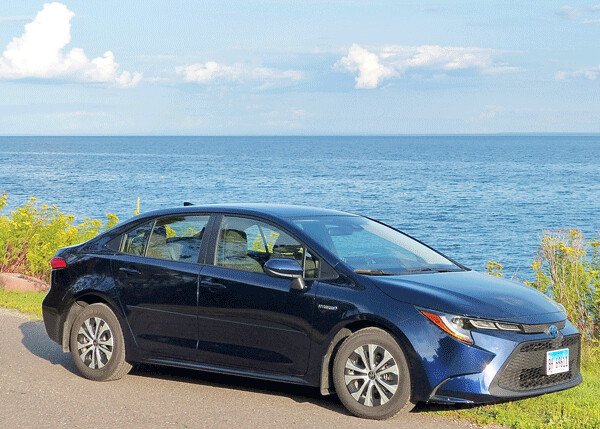Corolla Offers $24,000 Hybrid Alternative to Prius

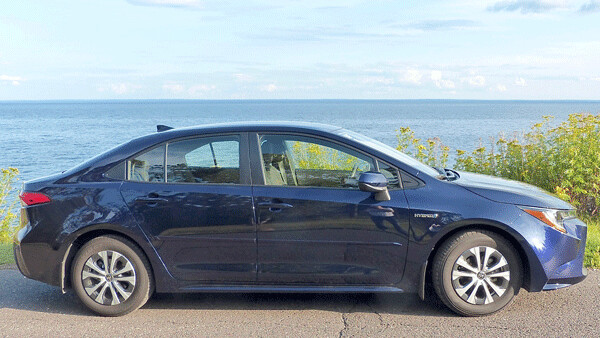
Driving along in a beautiful dark blue Toyota Corolla, we pulled around the corner and into an available parking space in West Duluth. We locked the Corolla with the key fob, and crossed the street, where we saw a man we know. He nodded toward the car and said, “If that your new test drive?”
I said yes, it was, and added that it was a 2020 Corolla, and it was a Hybrid.
“A Hybrid?” he responded.
I explained that for 2020 Toyota’s revamped Corolla compact line has a new global platform and a new body with stylish contours carved in. Corollas always have tried to look stylish-on-a-budget, but they haven’t been hybrids. And they haven’t been adorned with this impressive new “Blueprint” exterior paint.
“This one,” I said, “has the same drivetrain as the Prius I had driven a month or so earlier.”
“Well then,” he shot back, “why would anyone buy a Prius?:”
I didn’t quite see it that way, even though a lot of the masses might be to the point where they consider the Prius commonplace, even dull and uninteresting. I have driven the various Prius models all the way through their existence, and I can appreciate the evolutionary changes that have been made to the car to allow various models as newer electric motors have been designed, and more efficient methods of linking the electric motors to the gasoline engine, which controls the power and distributes it to the electric motors, which drive the car.
My acquaintance wouldn’t let up. “If it’s the same drivetrain, then why would you buy the Prius?” he asked. “The Corolla is much more car.”
There you have it. The strong opinion from the masses, which may not be influenced by the latest chances and improvements in technology, but they know what they like. I like the new Prius, particularly the all-wheel-drive model with its new edgy shape and phenomenal miles per gallon.
However, I also had to go back and find all my notes for comparison sake. The Prius, fixed with its instruments on the center of the dashboard, and its hatchback design, cost a base price of $28,810, and the AWD model I drove was $32,508. Well, I figured, technology costs money, ao that’s not so bad.
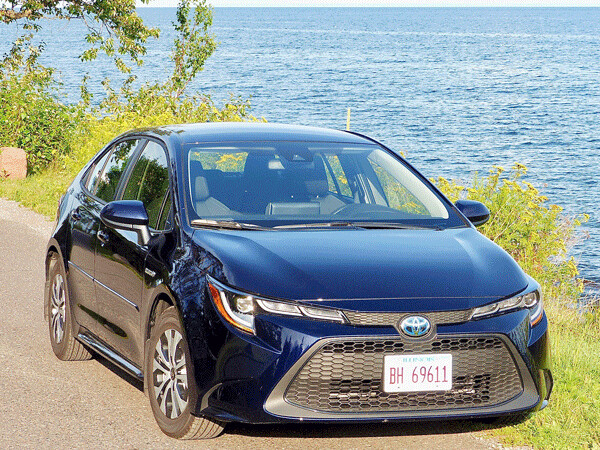
Then I looked at the Corolla Hybrid I had in my possession for that late-August week. It had a base price, in LE (middle) trim, of $22,950, and with only a couple of molding and floor mat options, the sticker read $24,467.
The surprising revelation was that the Corolla Hybrid and the Prius both were powered by Toyota’s 1.8-liter 4-cylinder, dual-overhead-cam, engine, with variable valve timing and Toyota’s revised fuel-management system, coupled with the Toyota Synergy Drive battery pack and electric motors. That is pretty close proximity for the front-wheel-drive Corolla and the all-wheel-drive Prius, both using their 121 combined horsepower and continuously variable transmission that has stepped shift-points that can be driven as though it is a 9-speed automatic, if you choose.
The Corolla is not a hatchback. It has a trunk. Amreican buyers have recently indicated that they don’t particularly like hatchbacks…in fact, research indicates we don’t like them, even though I find them often more flexible and useful than cars with trunks. But maybe that’s the secret behind putting the hybrid drivetrain out of the Prius into the Corolla. If you like a hatchback, buy the Prius; if you’d rather have a trunk, buy the Corolla Hybrid.
But I have just enough Scottish ancestry to add another part fo the equation: If you’d rather have $8,000 than commit it to your new car price, buy the Corolla!
The new Corolla looks a little more like a sporty compact than like an appliance, which long has been the primary criticism of all cars with Toyota surnames. The Camry and the Corolla have looked good for about a decade, but they do have something of a soap-carving-project look to them, when compared to cars like the Mazda3 and the Honda Civic — Corolla’s top two rivals — and the emerging challengers like Hyundai Elantra and Nissan Sentra.
The new Corolla shakes that image somewhat, but still seems that it is bound by stylists who are more worried about losing existing repeat buyers than making a move to become more stylish.
Inside, the driving position is improved, with better seats, more contemporary instruments and gauges, changeable at the touch of a button, or two, on the Swiss-Army-belt-like steering wheel.
The exterior has stylish 15-inch alloy wheels with all-season tires, and they support a whole range of contemporary safety and driver-aid features that hoist the Corolla up among the more accomplished models.
Start with a black mesh grille in front, a high-handed move for the usually conservative company, and the new grille spreads out to house LED headlights and daytime running lights, while at the rear, LED lights also brighten the tail and brake lights.
More significantly, the Toyota Safety Sense includes pre-collision aid with pedestrian warning, radar cruise control with full-range speed function, lane departure alert and assist, lane-tracing assist, automatic high beams with road-sign remote, stability control, traction control, electronic brake-force assist, and emergency stop assist.
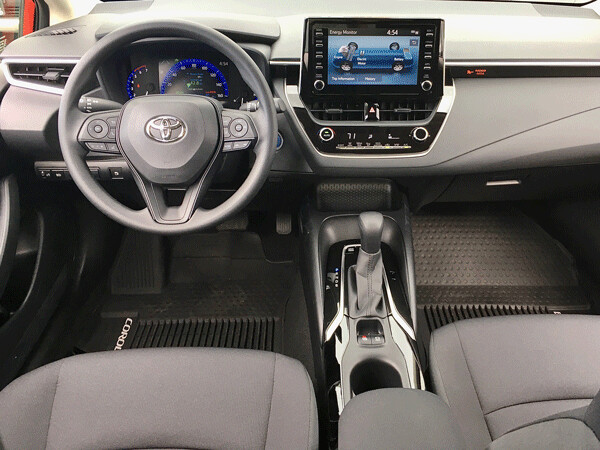
That accumulation of safety features is impressive enough even if you take them separately, and they are considerably more impressive when all combined into the Corolla package. New for 2010 is the inclusion of Apple CarPlay and a large touch-screen with assorted USB connectivity is all there.
The instrument panel is configurable, so if you don’t see the need for a tachometer in the left binnacle from the speedometer, you can change it over to trip statistics or other car function readouts. The center touch-screen is particularly useful because you can change that with a touch of a button, or the screen itself, to get things such as the power flow from the gas engine, the electric motor or the combination of both.
We also should avoid talking too much about the fold-down rear seats, because if you fold them down, elongating the trunk’s roomy storage area, you’re getting dangerously close to what hatchback-lovers like and hatchback-haters hate, and it does away with one of those difference between the Corolla Hybrid and the Prius.
We do still have the gauge package, which is directly through the steering wheel and in front of the driver, unlike the Prius, which has it over in the center, atop the dashboard. Driving the Prius still gives you the impression that you’re helping carry out a long-term experiment, while the Corolla is “just a car,” that you drive in more normal fashion.
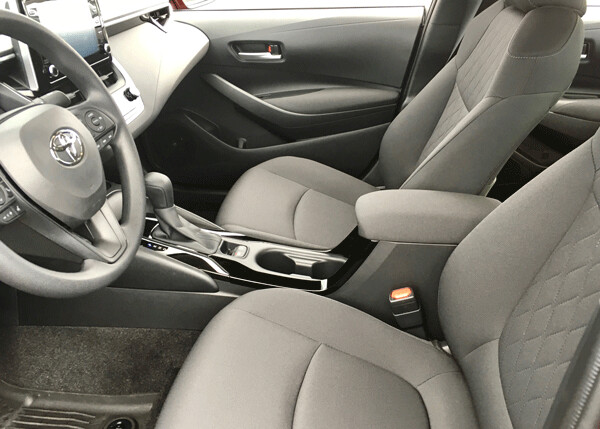
But when it gets time to refuel, the similarities override the differences. The Corolla, which looks like a nice, contemporary compact, gets over 50 miles per gallon routinely. The EPA estimates have a high of 53 miles per gallon in city driving and 52 on the highway. We got a pretty consistent 52 or 53 in town, and it didn’t change much when we went on a highway trip.
You’d have to be living in a cave or up in the mountains to be unaware that we’re heading rather swiftly toward a society that is driving electric cars, and we’re probably going to get to that point just about the time full-electric vehicles are ready to meet us. In the meantime, you can shop around for some highly efficient gas-engine cars, or you can select from an ever-expanding list of hybrid cars.
Some other hybrids compete well, and even favorably, with Toyota hybrids, but we also must acknowledge that Toyota has led the way with almost every step of hybrid growth. The Corolla Hybrid uses nickel-metal-hydride in its battery pack, while many competitors have gone to lithium-ion battery packs, claiming they charge faster, hold a charge longer, and deliver more power than the nickel-metal-hydride.
Toyota has some models that use lithium-ion, but when asked which is better, their engineers simply shrug, and put out the next generation of Priuses, and now Corollas. It seems that it’s still something of a secret that the Corolla has a Hybrid model, but for $24,000, it won’t be a secret for long.
